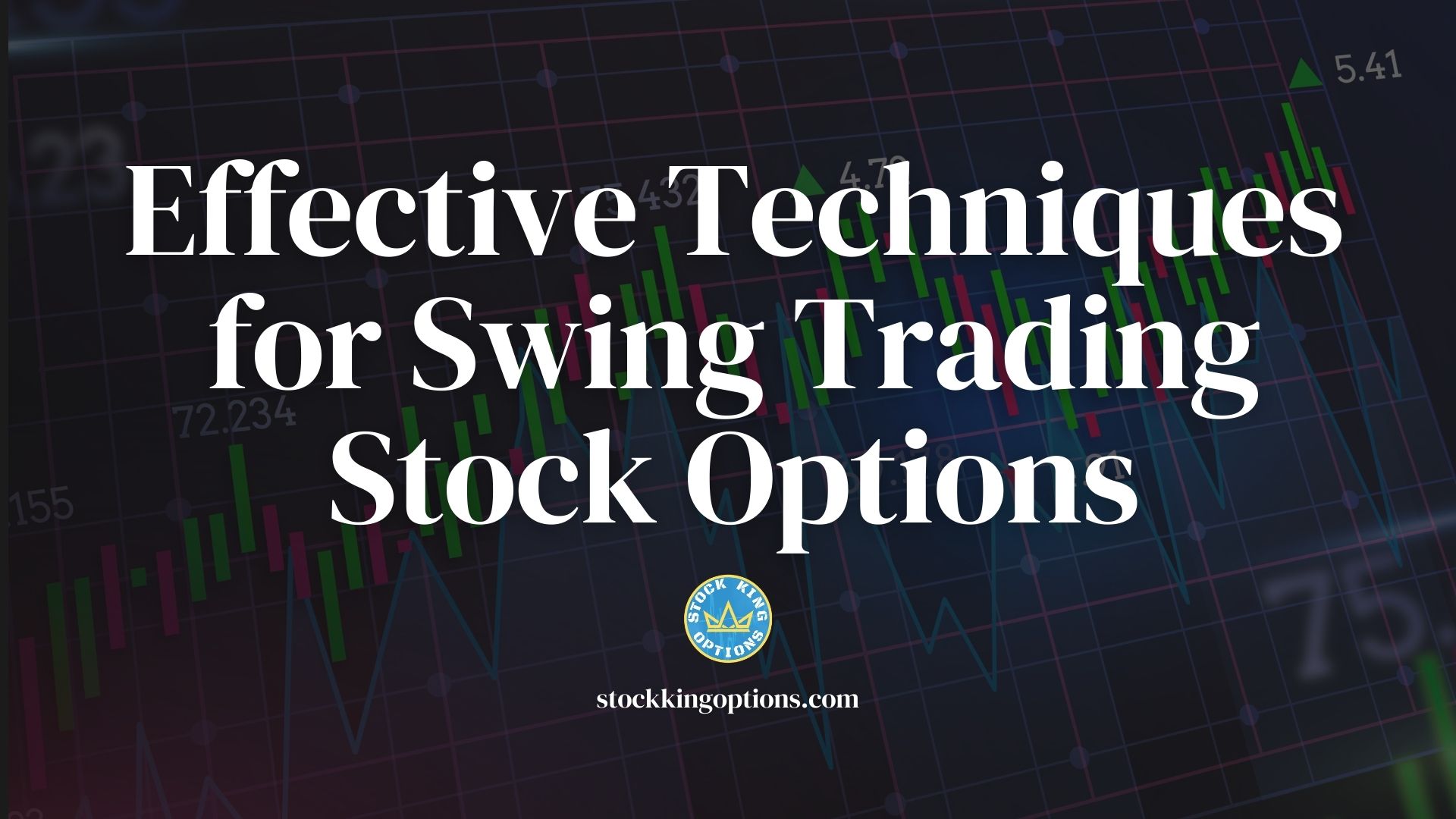
Key Takeaways:
- Swing trading stock options involves short- to medium-term trading strategies.
- Effective techniques include technical analysis, risk management, and understanding market trends.
- Implementing a disciplined approach and staying informed are key to success in this dynamic market.
Mastering the art of swing trading options requires a nuanced understanding of market dynamics and strategic decision-making. We’ve been trading the markets for 12 years using technical analysis. We’ve successfully been profitable over the year giving us the cache to become reliable traders. In this guide, we’ll delve into effective techniques tailored for those seeking to capitalize on short- to medium-term price movements in the options market. From employing technical analysis tools to mitigating risks, we’ll explore essential strategies to help you navigate this fast-paced arena with confidence. Whether you’re a novice trader or seasoned investor, honing these techniques can enhance your ability to identify profitable opportunities and manage trades effectively.
Featured Snippet:
Question: What are effective techniques for swing trading stock options?
Answer: Effective techniques for swing trading stock options involve employing technical analysis, implementing risk management strategies, and staying abreast of market trends. These techniques enable traders to capitalize on short- to medium-term price movements in the options market with confidence and discipline.
Technical Analysis
Technical analysis is a method of evaluating and forecasting the movement of stock prices by analyzing historical market data, such as price charts and trading volume. It relies on the belief that market trends tend to repeat themselves and that past patterns can help predict future price movements.
One of the key principles of technical analysis is that all available information about a stock is reflected in its price. This means that instead of focusing on external factors like company news or economic conditions, technical analysts focus solely on the price action and volume of a stock. By identifying certain patterns and trends in this data, traders can make informed decisions about when to enter or exit a trade.
There are various tools and techniques used in technical analysis, but some of the most commonly used ones include trend lines, support and resistance levels, moving averages, and chart patterns. Let’s take a closer look at each of these techniques:
1. Trend Lines: A trend line is simply a straight line drawn between two consecutive high or low points on a price chart. It helps identify the direction of an uptrend or downtrend for a particular stock.
2. Support & Resistance Levels: These levels are areas where buying pressure (support) or selling pressure (resistance) has been consistently strong in the past. They act as important psychological barriers for stock prices.
3. Moving Averages: This technique involves calculating an average price over a specific time period to smooth out short-term fluctuations in stock prices. Traders typically use 50-day and 200-day moving averages for swing trading options.
4. Chart Patterns: There are several chart patterns identified by technical analysts that indicate potential changes in market sentiment. Some examples include head-and-shoulders, double tops/bottoms, triangles, flags, etc.
While using these techniques alone may not guarantee success in swing trading options, they can definitely provide valuable insights into market behavior and help traders make more informed decisions based on sound reasoning rather than emotions. It’s important to note that technical analysis is not an exact science and should be used in conjunction with other forms of analysis, such as fundamental analysis, to get a more holistic view of the market.
Technical analysis is an essential tool for swing trading stock options. By studying price charts, volume data and identifying patterns and trends, traders can make informed decisions based on market behavior and improve their overall chances of success in the stock market. Remember, it takes time and practice to become skilled at technical analysis, so don’t hesitate to seek guidance from experienced traders or invest in educational resources to hone your skills.
Fundamental Analysis
Fundamental analysis is a key aspect of successfully swing trading stock options. It involves evaluating the overall health and performance of a company, including its financial statements, management team, industry trends, and economic conditions. By understanding the underlying value of a company, traders can make more informed decisions on when to buy or sell options.
One of the most important elements of fundamental analysis is analyzing a company’s financial statements. This includes looking at its balance sheet, income statement, and cash flow statement. These documents provide valuable insights into a company’s assets, liabilities, revenue streams, and expenses.
Another crucial aspect of fundamental analysis is examining the management team of a company. This includes evaluating their track record, experience in the industry, and decision-making processes. A strong and competent management team can greatly impact the success of a company and ultimately influence its stock price.
It’s also essential to keep an eye on industry trends when conducting fundamental analysis. Understanding how external factors such as market demand and competition affect a company’s performance can help identify potential risks and opportunities.
Economic conditions are another crucial factor to consider when performing fundamental analysis. Factors such as interest rates, inflation rates, GDP growth rates can have a significant impact on companies across various industries. Therefore it’s important to stay updated with economic news that could potentially affect your chosen stocks.
In addition to these main areas of focus, there are several other key metrics to consider during fundamental analysis. These include but are not limited to earnings per share (EPS), price-to-earnings ratio (P/E), return on equity (ROE), debt-to-equity ratio (D/E), and many others.
While technical analysis focuses more on short-term price movements based on chart patterns and market indicators, fundamental analysis provides traders with a long-term perspective by looking at the bigger picture behind stock prices.
However it’s worth noting that while fundamental analysis provides valuable insights into the overall health of companies being traded, it should not be the sole factor in decision-making for swing trading stock options. Combining fundamental analysis with technical analysis and market sentiment can help traders make well-informed decisions on when to enter or exit a trade.
Understanding fundamental analysis is crucial for effective swing trading of stock options. By diligently evaluating a company’s financials, management team, industry trends, and economic conditions, traders gain a deeper understanding of the true value of a company’s stocks and can make more strategic trading decisions.
Timing the Market
Timing the market is a crucial aspect of swing trading stock options. It involves analyzing both technical and fundamental factors to determine the best entry and exit points for trades. Many successful traders have mastered the art of timing the market, as it can significantly increase their profits while minimizing their risks.
One important factor in timing the market is understanding market trends. This refers to studying price movements over a period of time and identifying patterns that can help predict future price movements. Traders often use indicators such as moving averages, trend lines, and support and resistance levels to identify trends in the market.
It is also essential to pay attention to news and events that may affect the stock’s price. Economic data, company earnings reports, or even political developments can impact markets and cause significant price fluctuations. As a
swing trader, it is important to be aware of any upcoming news or events that may affect your positions.
Another critical aspect of timing the market is observing volume. Volume refers to the number of shares being traded at any given time. A higher volume suggests more interest in a particular stock, which could indicate potential buying opportunities for traders.
In addition to technical aspects, cognitive biases also play a significant role in timing the market. It is common for traders to experience emotions such as fear or greed when making decisions about buying or selling stocks. These emotions can potentially cloud judgment and lead to poor decision-making. Therefore, it is crucial for swing traders to maintain discipline and stick with pre-planned strategies rather than reacting based on emotions.
Furthermore, using stop-loss orders can be an effective technique for managing risk when timing the market. A stop-loss order allows traders to set a predetermined point at which they will automatically sell their stock if it reaches a certain price level. This approach helps limit losses if trades do not go according to plan.
Timing the market also involves taking into account both short-term and long-term factors when making trading decisions. Short-term factors, such as intra-day price movements, can help identify potential entry and exit points for a trade. On the other hand, long-term factors, such as company performance and industry trends, can provide insight into a stock’s potential growth or decline over time.
Timing the market requires a combination of technical analysis, fundamental knowledge, discipline, and awareness of emotional biases. By mastering this skill, swing traders can maximize their profits while minimizing their risks in the fast-paced world of stock options trading.




